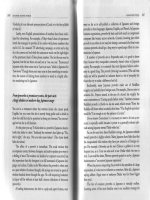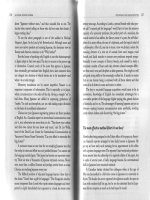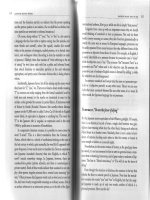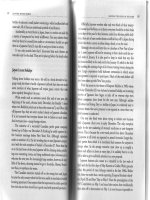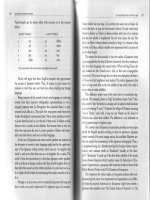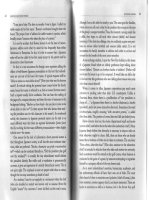doug lemov teach like a champion
Bạn đang xem bản rút gọn của tài liệu. Xem và tải ngay bản đầy đủ của tài liệu tại đây (2.65 MB, 355 trang )
TEACH LIKE
A CHAMPION
49 Techniques
that Put Students on
the Path to College
Doug Lemov
Foreword by Norman Atkins
JOSSEY-BASS TEACHER
Jossey-Bass Teacher provides educators with practical knowledge and tools to
create a positive and lifelong impact on student learning. We offer classroomtested and research-based teaching resources for a variety of grade levels and
subject areas. Whether you are an aspiring, new, or veteran teacher, we want to
help you make every teaching day your best.
From ready-to-use classroom activities to the latest teaching framework, our
value-packed books provide insightful, practical, and comprehensive materials on
the topics that matter most to K–12 teachers. We hope to become your trusted
source for the best ideas from the most experienced and respected experts in the
field.
TEACH LIKE
A CHAMPION
49 Techniques
that Put Students on
the Path to College
Doug Lemov
Foreword by Norman Atkins
Copyright © 2010 by John Wiley & Sons, Inc. All rights reserved.
Published by Jossey-Bass
A Wiley Imprint
989 Market Street, San Francisco, CA 94103-1741— www.josseybass.com
No part of this publication may be reproduced, stored in a retrieval system, or transmitted in any form or by any means,
electronic, mechanical, photocopying, recording, scanning, or otherwise, except as permitted under Section 107 or 108 of the
1976 United States Copyright Act, without either the prior written permission of the publisher, or authorization through
payment of the appropriate per-copy fee to the Copyright Clearance Center, Inc., 222 Rosewood Drive, Danvers, MA 01923,
978-750-8400, fax 978-646-8600, or on the Web at www.copyright.com. Requests to the publisher for permission should be
addressed to the Permissions Department, John Wiley & Sons, Inc., 111 River Street, Hoboken, NJ 07030, 201-748-6011, fax
201-748-6008, or online at www.wiley.com/go/permissions.
Except as expressly noted below, no part of this publication may be reproduced, stored in a retrieval system, or transmitted
in any form or by any means, electronic, mechanical, photocopying, recording, scanning, or otherwise, except as permitted
under Section 107 or 108 of the 1976 United States Copyright Act, without either the prior written permission of the
Publisher, or authorization through payment of the appropriate per-copy fee to the Copyright Clearance Center, Inc., 222
Rosewood Drive, Danvers, MA 01923, 978-750-8400, fax 978-750-4470, or on the web at www.copyright.com. Requests to
the Publisher for permission should be addressed to the Permissions Department, John Wiley & Sons, Inc., 111 River Street,
Hoboken, NJ 07030, 201-748-6011, fax 201-748-6008, e-mail:
Certain pages from this book (except those for which reprint permission must be obtained from the primary sources) are
designed for educational/training purposes and may be reproduced. These pages are designated by the appearance of a
copyright notice at the foot of the page.
“See It in Action” boxes and Behind-the-Scene Interviews Copyright © 2010 by Uncommon Schools
Reflection and Practices at the end of each chapter Copyright © 2010 by Uncommon Schools
Part Two Copyright © 2010 by Uncommon Schools and Doug Lemov
Permission is given for individual classroom teachers to reproduce the pages and illustrations for classroom use.
Reproduction of these materials for an entire school system is strictly forbidden.
The materials on the accompanying DVD are designed for use in a group setting and may be used for educational/training
purposes.
This free permission is restricted to limited use of the DVD materials for your organization and for educational/training
events. It does not allow for systematic or large-scale reproduction, distribution, transmission, electronic reproduction, or
inclusion in any publications offered for sale or used for commercial purposes—none of which may be done without prior
written permission of the Publisher.
Readers should be aware that Internet Web sites offered as citations and/or sources for further information may have changed
or disappeared between the time this was written and when it is read.
Limit of Liability/Disclaimer of Warranty: While the publisher and author have used their best efforts in preparing this book,
they make no representations or warranties with respect to the accuracy or completeness of the contents of this book and
specifically disclaim any implied warranties of merchantability or fitness for a particular purpose. No warranty may be
created or extended by sales representatives or written sales materials. The advice and strategies contained herein may not be
suitable for your situation. You should consult with a professional where appropriate. Neither the publisher nor author shall
be liable for any loss of profit or any other commercial damages, including but not limited to special, incidental,
consequential, or other damages.
Jossey-Bass books and products are available through most bookstores. To contact Jossey-Bass directly call our Customer
Care Department within the U.S. at 800-956-7739, outside the U.S. at 317-572-3986, or fax 317-572-4002.
Jossey-Bass also publishes its books in a variety of electronic formats. Some content that appears in print may not be
available in electronic books.
Library of Congress Cataloging-in-Publication Data
Lemov, Doug, 1967Teach like a champion: 49 techniques that put students on the path to college / Doug Lemov; foreword by Norman Atkins
Jossey-Bass.—1st ed.
p. cm.
Includes index.
ISBN 978-0-470-55047-2 (paper/dvd)
1. Effective teaching. 2. Academic achievement. 3. College preparation programs. I. Title.
LB1025.3.L48 2010
371.3— dc22
2009049498
Printed in the United States of America
FIRST EDITION
PB Printing 10 9 8 7 6 5 4 3 2 1
CONTENTS
DVD Contents
ix
Foreword
xi
Acknowledgments
xv
The Author
xix
Introduction: The Art of Teaching and Its Tools
1
PART ONE
TEACH LIKE A CHAMPION: THE ESSENTIAL TECHNIQUES
1
Setting High Academic Expectations
Technique 1: No Opt Out
Technique 2: Right Is Right
Technique 3: Stretch It
Technique 4: Format Matters
Technique 5: Without Apology
Reflection and Practice
27
28
35
41
47
51
55
2
Planning that Ensures Academic Achievement
Technique 6: Begin with the End
Technique 7: 4 Ms
Technique 8: Post It
Technique 9: Shortest Path
Technique 10: Double Plan
Technique 11: Draw the Map
Reflection and Practice
57
57
60
63
64
65
67
69
3
Structuring and Delivering Your Lessons
Technique 12: The Hook
Technique 13: Name the Steps
Technique 14: Board = Paper
71
75
77
82
v
vi
Contents
Technique 15: Circulate
Technique 16: Break It Down
Technique 17: Ratio
Technique 18: Check for Understanding
Technique 19: At Bats
Technique 20: Exit Ticket
Technique 21: Take a Stand
Reflection and Practice
84
88
92
97
104
106
106
108
4
Engaging Students in Your Lessons
Technique 22: Cold Call
Technique 23: Call and Response
Technique 24: Pepper
Technique 25: Wait Time
Technique 26: Everybody Writes
Technique 27: Vegas
Reflection and Practice
111
111
125
131
134
137
141
144
5
Creating a Strong Classroom Culture
Technique 28: Entry Routine
Technique 29: Do Now
Technique 30: Tight Transitions
Technique 31: Binder Control
Technique 32: SLANT
Technique 33: On Your Mark
Technique 34: Seat Signals
Technique 35: Props
Reflection and Practice
145
151
152
154
157
158
159
161
163
165
6
Setting and Maintaining High Behavioral Expectations
Technique 36: 100 Percent
Technique 37: What to Do
Technique 38: Strong Voice
Technique 39: Do It Again
Technique 40: Sweat the Details
Technique 41: Threshold
Technique 42: No Warnings
Reflection and Practice
167
167
177
182
191
195
197
199
201
Contents
vii
7
Building Character and Trust
Technique 43: Positive Framing
Technique 44: Precise Praise
Technique 45: Warm/Strict
Technique 46: The J-Factor
Technique 47: Emotional Constancy
Technique 48: Explain Everything
Technique 49: Normalize Error
Reflection and Practice
203
204
210
213
214
219
220
221
223
8
Improving Your Pacing: Additional Techniques for
Creating a Positive Rhythm in the Classroom
Change the Pace
Brighten Lines
All Hands
Every Minute Matters
Look Forward
Work the Clock
Reflection and Practice
225
9
Challenging Students to Think Critically: Additional
Techniques for Questioning and Responding to Students
One at a Time
Simple to Complex
Verbatim (No Bait and Switch)
Clear and Concise
Stock Questions
Hit Rate
Reflection and Practice
226
228
229
230
231
232
233
235
237
239
240
240
241
243
245
PART TWO
HELPING STUDENTS GET THE MOST OUT OF READING:
CRITICAL SKILLS AND TECHNIQUES
10 How All Teachers Can (and Must) Be Reading Teachers
249
11 The Fundamentals: Teaching Decoding, Vocabulary
263
Development, and Fluency
viii
Contents
12 Comprehension: Teaching Students to Understand
283
What They Read
Conclusion: The End Is the Beginning
309
Appendix: Behind-the-Scenes Interviews
311
Index
325
How to Use the DVD
331
DVD CONTENTS
Clip 1
No Opt Out/31
Darryl Williams
Clip 2
Right Is Right/36
Annette Riffle
Clip 3
Right Is Right/40
Jason Armstrong
Clip 4
Right Is Right and Stretch It/45
Clip 5
Format Matters/49
Clip 6
Circulate/87
Clip 7
Cold Call/Pepper/123
Clip 8
Cold Call/124
Clip 9
Cold Call and Vocabulary/124
Leah Bromley
Darryl Williams
Domari Dickinson
Jesse Rector
Colleen Driggs
Beth Verilli
Clip 10 Pepper and Every Minute Matters/133
Annette Riffle
Clip 11 Wait Time/137
Colleen Driggs
Clip 12 Everybody Writes/140
Art Worrell
Clip 13 Tight Transitions and Positive Framing/157
Clip 14 100 Percent and What to Do/171
Doug McCurry
Ashley Buroff
Clip 15 100 Percent/173
Jaimie Brillante
Clip 16 100 Percent/174
Bob Zimmerli
Clip 17 Strong Voice/187
Sultana Noormuhammad
Clip 18 Do It Again/194
Suzanne Vera
Clip 19 Positive Framing/210
Janelle Austin
Clip 20 Joy Factor/218
Clip 21 Joy Factor and Tight
Transitions/218
George Davis
Sultana Noormuhammad
ix
x
DVD Contents
Clip 22 Control the Game/261
Hilary Lewis
Clip 23 Fluency/279
Roberto de Leon
Clip 24 Fluency/281
Hannah Lofthus
Clip 25 Vocabulary and Comprehension/297
Roberto De Leon
FOREWORD
If John Madden— enthusiastically drawing Xs, Os, and squiggly lines on our TV
screens, diagramming games, down by down—is the explainer par excellence of
professional football, Doug Lemov is the John Madden of professional teaching.
For the past dozen years, he has been standing in the back of hundreds of
classrooms, watching thousands of hours of teachers’ game films, and analyzing
their teaching moves with more enthusiasm and attention to detail than virtually
anyone else in the history of American education.
He’s gone about this systematically and with a tremendous sense of purpose, creating and poring over countless scatter-plot charts. When Lemov graphs
schools by two variables—their academic performance on the y-axis and the
poverty index of their students on the x -axis—he invariably finds a line of regression that indicates students’ test scores are highly correlated with the amount of
money their parents make and the zip codes where they live. If he were a sociologist, he’d conclude what far too many children growing up in poverty, even in
this land of opportunity, already know from experience: demography is destiny.
Now having taught and served as a principal of a school where low-income
students triumphed over their putative demographic fate, Lemov is always mining
for more promising data in the service of a more urgent mission: the fight for
educational equity. He is not interested in the line of regression so much as
the very few dots in the upper-right-hand corner of the charts soaring several
standard deviations above their predicted place on the line. These dots represent
nonselective schools that serve primarily students who receive subsidized lunch
and, at the same time, score better on the state test than their more affluent peers.
For the past decade, Lemov has run to these schools, identified the teachers
generating the remarkable results, camped out in their classrooms, and watched
the tiniest details, from how they greet students at the door to how they pass out
papers, from how they cold-call students to how they wait for answers. He has
documented and built a database of thirty-second video clips of these moves.
What he discovered is surprising for its simplicity and portends good news
for the teaching profession. He did not find magicians mixing secret alchemical
teaching potions or derive the elusive DNA for charisma. And, more important, he
did not unearth any truth behind the pernicious lie that the most effective teachers
xi
xii
Foreword
simply come across well because they have the easiest or brightest students.
No, what he repeatedly saw and captured on video, beyond the no-shortcuts
preparation and an essential mind-set of high expectations, were highly skilled
individuals, working with a common, discrete set of tools, building systems of
classroom culture and instruction, brick by brick.
He could see that teaching was not as easy or straightforward as the home
improvement projects he was doing on the weekend, but he also knew that there
was a craft to it that could be taught and learned. His big “aha” was to identify
the tools that master teachers used to make their classrooms into cathedrals of
learning.
He began naming and codifying these techniques— Strong Voice, Positive
Framing, Stretch It —in a new taxonomy of effective teaching practices. In the
past five years at Uncommon Schools, a nonprofit charter school management
organization I founded and where Lemov has served as a managing director, creating schools in Rochester and Troy, New York, the taxonomy has gone through
more than twenty-five revisions as he has observed and videotaped our “rock
star” teachers in action and refined his concepts based on their work.
One of Lemov’s earliest and most important insights was that he could use
videotape as a window into the classrooms of the most effective teachers. He
found a way on tape to isolate the microtechniques that make all the difference
in student learning. In the same way that Madden might show in slow motion
replay how the left tackle blocked for the quarterback, Lemov can show how a
teacher stretches students’ answers in a discussion.
Uncommon Schools has trained hundreds of its own teachers using the taxonomy and videos. Moreover, Uncommon and Lemov have trained thousands of
other teachers, as well as hundreds of school leaders, who in turn have trained
tens of thousands of their teachers. It has become the instructional Baedeker for
the highest-performing teachers and schools across the United States. Lemov’s
language of Strong Voice, Positive Framing, Right Is Right, 100 Percent, and all
the others has increasingly entered the common lexicon of new teachers in charter schools. At Teacher U, a new teacher training program created by Uncommon
Schools, KIPP, and Achievement First, we are training the next generation of
teachers in the tools described in the taxonomy.
For years now, various sections of the taxonomy have been passed around,
teacher to teacher, as dog-eared copies or unauthorized PDFs, as if it were revolutionary samizdat literature. Many of us have been urging Lemov to publish
the work and share it with the nation’s three million teachers who will benefit
from its insights. At long last, I am pleased to say, you are holding that book in
Foreword
xiii
your hands. Teach Like a Champion is essential reading for those who intend to
make every moment count in their classrooms, who want to build a repertoire
of skills that will help them lead all their students to meaningful achievement,
who are all about getting down to the work of ensuring that demography is not
destiny for our children and our nation.
Unlike Madden, Lemov is more professor than football coach; he’s not a loud
or in-your-face personality. At the same time, his love of teachers and Maddenlike enthusiasm for their teaching shine through every page in this book. He
has given teachers a tremendous gift: a beautiful set of tools that they can use
to become successful (assuming, of course, that they work relentlessly!) at the
world’s greatest profession.
Norman Atkins
Founder and CEO of Teacher U;
founder, former CEO, and board chair of Uncommon Schools;
cofounder and former codirector of North Star Academy;
former coexecutive director of the Robin Hood Foundation
For Mike and Penny Lemov
My first teachers
ACKNOWLEDGMENTS
My friend and colleague Norman Atkins likes to start up audacious projects.
He founded Newark’s North Star Academy, the most successful charter school
in New Jersey, and arguably one of the best public schools in the country. He
founded Uncommon Schools, the network of sixteen college preparatory charter
schools (so far!) in high-need school districts in New York and New Jersey. He
founded Teacher U, the teacher training program and graduate school in New
York City that has reinvented the process of teacher education to focus it on what
gets real results in real classrooms. All in all, not a bad decade’s work.
Norman wills projects into being when he believes they can help eliminate
the gap between the achievement levels of poor and privileged students. And he
got it into his head that one of those projects was the “taxonomy,” the impromptu
list I was making of what great teachers did in their classrooms. It should be a
book, Norm advised. I said no in a lot of very clear ways. But Norman nagged
me. For every excuse he had a solution, usually delivered with exuberance and
gesticulating. And in the end I knew it would be easier to write the thing than
to battle Norman’s will. Now that you hold the result in your hands, it’s fitting
that I start with thanks to Norman for his tenacity and faith.
That said, having written this book on the techniques that champion teachers
use, thanking all those inspiring and brilliant teachers should by all rights be
my starting point. And as it seemed right to name names, I started in on a
comprehensive list. The challenge proved daunting, though, and when I got over
fifty names, I realized that to try to name all the teachers I’d learned from in
writing this book would yield a list both unwieldy and unforgivable in the worthy
individuals it left out, either because I somehow forgot a few or because in some
cases it felt strange to be thanking people I’d barely met. Ironically, some of
the teachers who were influential in writing this I watched anonymously from
the back of the classroom or even on video tape. So with perhaps a hundred
apologies, I’ve made the gut-wrenching decision to offer a blanket thank-you to
all the teachers I’ve worked with, even though I’m chastened by the ingratitude
this shows. There are so many, especially at Uncommon Schools, who have
taught me every piece of insight contained in this book while also, and more
important, teaching class after class of deserving students to aspire, reach, and
xv
xvi
Acknowledgments
achieve. My heartfelt thanks to all of those champions, alongside those of their
students and their parents.
A second source of the inspiring success those teachers have achieved is
the leadership they get from their principals in putting them in a position to
succeed. And in this case I owe thanks to Stacey Shells, the founding principal
of Rochester Prep, the first Uncommon School in upstate New York, as well as
Paul Powell and David McBride, instructional leaders with whom I am lucky to
work and from whom I have learned much.
I’m also deeply indebted to the “taxonomy team” at Uncommon— the folks
whose work it is to take hours of teacher video and turn it into teacher training modules that help ensure the success of novice teachers and the continued
development of veterans. On that team are Tracey Koren, Max Tuefferd, Erica
Woolway, John Costello, Melinda Phelps, Katie Yezzi, and, most of all, my
friend and colleague Rob Richard. Rob, who directs the taxonomy video project,
is my indispensable partner in developing the material in this book (especially
the DVD) and a reliable source of music recommendations for late-night drafting
and editing of books.
Also, my fellow managing directors at Uncommon—Paul Bambrick, John
King, and Brett Peiser—as well as chief operating officer Josh Phillips and chief
executive officer Evan Rudall, have provided me with invaluable advice and
insight into all aspects of the work we do, including the contents of this book.
The chapters in Part Two on reading are particularly indebted to John King’s
constant inquiry and counsel.
This book, and the larger teacher training project of which it is a part, would
have been impossible without the generous support and guidance of the Carnegie
Corporation of New York and the Kern Family Foundation. Both organizations
placed great faith in me, in Uncommon Schools, and in our programs. To them
and to Ryan Olson, Jim Rahn, and Talia Milgrom-Elcott in particular, I am deeply
grateful.
Over the five or so years I spent writing this book, I received invaluable
editing support from Sophie Brickman, Karen Lytle, Jessica Petrencsik, and Jennifer Del Greco. Kate Gagnon at Jossey-Bass found a way to shape and refine
the whole messy bee’s nest of a project into a cohesive whole. Of the many
peers and colleagues who have given me regular feedback about how to improve
this work over the years, none has been more diligent and candid than Doug
McCurry, co-CEO of Achievement First.
Finally my biggest debt of all is to my wife, Lisa, with whom I share the
responsibility for and joy in the most important work I will ever do: raising our
Acknowledgments
xvii
three children. She picked up much of my part of that so I could write. That
said, thanking Lisa for her help with this book is a bit like thanking the sun.
Sure, there would be no book without light to write by, but it’s hard to feel as
if the thank-you doesn’t trivialize a gift of such magnitude. Still you gotta try.
So, Lisa, thank you for the hours squeezed out of Sunday mornings and Tuesday
nights and all the extra work this meant for you. Thank you for talking ideas
through with me while handing snacks and drinks into the back seat. And most
of all, thank you for the sunshine.
THE AUTHOR
Doug Lemov is a managing director of Uncommon Schools and oversees its True
North network, with schools in Rochester and Troy. He also trains school leaders
and teachers both internally, at Uncommon’s sixteen schools, and nationally.
He was formerly the president of School Performance, an organization helping
schools use data to drive decision making, and vice president for accountability
at the State University of New York Charter Schools Institute and was a founder
and principal of the Academy of the Pacific Rim Charter School in Boston.
He has taught English and history at the university, high school, and middle
school levels. He holds a B.A. from Hamilton College, an M.A. from Indiana
University, and an M.B.A. from the Harvard Business School. Visit Doug Lemov
at www.douglemov.com.
xix
INTRODUCTION
THE ART OF TEACHING
AND ITS TOOLS
Great teaching is an art. In other arts—painting, sculpture, the writing of
novels—great masters leverage a proficiency with basic tools to transform the
rawest of material (stone, paper, ink) into the most valued assets in society. This
alchemy is all the more astounding because the tools often appear unremarkable
to others. Who would look at a chisel, a mallet, and a file and imagine them
producing Michelangelo’s David ?
Great art relies on the mastery and application of foundational skills, learned
individually through diligent study. You learn to strike a chisel with a mallet. You
refine the skill with time, learning at what angle to strike and how hard to drive
the chisel. Years later, when and if your work makes it to a museum, observers
will likely talk about what school of thought or theory it represents. They are far
less likely to reflect on the degree to which proficiency with the chisel made the
vision possible. But although lots of people conjure unique artistic visions, only
those with an artisan’s skill can make them real. Behind every artist is an artisan.
And while not everyone who learns to drive a chisel will create a David , neither
can anyone who fails to learn it do much more than make marks on rocks.
Traveling abroad during my junior year in college, I saw Picasso’s school
notebooks on display at the Picasso Museum in Barcelona. What I remember
best are the sketches in the margins of his pages. These weren’t sketchbooks,
mind you. These were notebooks like every student keeps: page after page of
notes from lectures. But the sketches in the margins memorialized a teacher’s
face or Picasso’s own hand grasping a pencil with perfect perspective, line, and
shading. I had always thought Picasso was a king of abstraction, of a symbolism
1
2
Introduction
that made the ability to draw accurately and realistically irrelevant. His sketches,
filling the margins of the pages, bore witness to his mastery of fundamentals and
a habitual need to refine his skills. Even in the stray moments of his schooling,
he was constantly honing the building blocks of his technique. He was an artisan
first and then an artist, as the fact that he filled, by one count, 178 sketchbooks
in his life further attests. Diligent mastery of the tools of the craft preceded and
perhaps allowed what came after.
This book is about the tools of the teaching craft. More specifically, it’s
about the tools necessary for success in the most important part of the field:
teaching in public schools, primarily those in the inner city, that serve students
born into poverty and, too often, to a rapidly closing window of opportunity. In
these schools, the price of failure is high and the challenges immense. Teachers
there work in a crucible where, most often, our society’s failures are paramount,
self-evident, and overwhelming, but also where the kind of alchemy that changes
lives can and does occur. Unfortunately this alchemy happens too rarely and often
without much fanfare. But in the hands of a small number of champion teachers
and visionary principals who’ve managed to build classrooms and schools that
successfully pry the window of opportunity back open, it happens reliably and
consistently. If you’re reading this and you’re a teacher who wants to improve
your craft, my aim is to give you the tools to do that—to become one of those
teachers who unlocks the latent talent and skill waiting in his or her students, no
matter how many previous schools or classrooms or teachers have been unsuccessful in that task.
Throughout my career working in urban public schools as a teacher, trainer,
consultant, and administrator, I’ve had the privilege of watching many champion
teachers, often in situations that would overwhelm most of us. These outstanding teachers routinely do what a thousand hand-wringing social programs have
found impossible: close the achievement gap between rich and poor, transform
students at risk of failure into achievers and believers, and rewrite the equation
of opportunity. And while each of these teachers is unique, their teaching holds
certain elements in common. After years of observing and having read the work
of Jim Collins, the author of the highly lauded books Built to Last and Good
to Great, then I began to make a list of what it was these teachers did, focusing in particular on the techniques that separated great teachers not from weak
teachers but from those who were merely good. As Collins points out, this is
much more relevant and revealing than what distinguishes great from poor or
mediocre performers since the findings provide a road map to excellence. Over
time my list grew in both the number of topics and the level of specificity in


